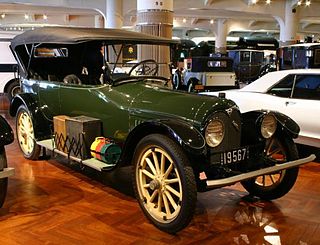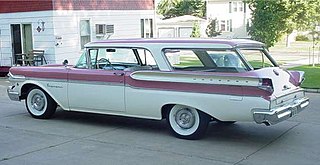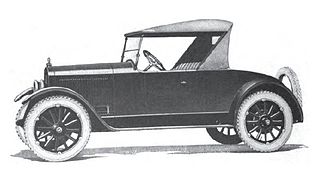Related Research Articles

The Winton Motor Carriage Company was a pioneer United States automobile manufacturer based in Cleveland, Ohio. Winton was one of the first American companies to sell a motor car. In 1912 Winton became one of the first American manufacturers of diesel engines.

The Apperson was a brand of American automobile manufactured from 1901 to 1926 in Kokomo, Indiana.

Baker Motor Vehicle Company was an American manufacturer of Brass Era electric automobiles in Cleveland, Ohio, from 1899 to 1914.
Berg Automobile Company was a manufacturer of automobiles in Cleveland, Ohio, established by Hart O. Berg and operational from 1903 to 1904. The New York Bergs were made by the Worthington Automobile Company.
Buffalo Electric Carriage Company was a Brass Era manufacturer of electric automobiles in Buffalo, New York.

The Eldredge was an American automobile manufactured from 1903 until 1906. A product of the National Sewing Machine Company of Belvidere, Illinois, it was a light, two-seater runabout with left-hand drive or two-row tonneau.

Elmore Manufacturing Company was a manufacturer of veteran and brass era automobiles and bicycles (1893–97), headquartered at 504 Amanda Street, Clyde, Ohio, from 1893 until 1912. The company took its name from a small parcel of land in Clyde with the name Elmore associated with it where a stave mill was established originally, then evolved into bicycle production. The village of Elmore, Ohio is located 20 mi (32.2 km) to the east. Founded by Harmon Von Vechten Becker and his two sons, James and Burton, the Elmore used a two-stroke engine design, in straight twin or single-cylinder versions. They later produced a straight-3 followed by a straight-4 beginning in 1906 until production ended in 1912. The company advertising slogan was "The Car That Has No Valves", referring to the two-stroke engine.

Haynes-Apperson Company was a manufacturer of Brass Era automobiles in Kokomo, Indiana, from 1896 to 1905. It was the first automobile manufacturer in Indiana, and among the first in the United States. Elwood Haynes, one of the founders, worked on early types of stainless steel and was the inventor of stellite, and many of the early advances in automobile technology were first invented by the company.
The National Motor Vehicle Company was an American manufacturer of automobiles in Indianapolis, Indiana, between 1900 and 1924. One of its presidents, Arthur C. Newby, was also one of the investors who created the Indianapolis Motor Speedway.
Phelps Motor Vehicle Company was a manufacturer of automobiles in Stoneham, Massachusetts, between 1903 and 1905.

The Pope-Toledo was the luxury marque of the Pope Motor Car Company founded by Colonel Albert A. Pope, and was a manufacturer of Brass Era automobiles in Toledo, Ohio between 1903 and 1909. The Pope-Toledo was the successor to the Toledo of the International Motor Car Company.

The first Cadillac automobiles were the 1903 Model built in the last quarter of 1902. These were 2-seater "horseless carriages" powered by a reliable and sturdy 10 hp (7 kW) single-cylinder engine developed by Henry Martyn Leland and built by Leland and Faulconer Manufacturing Company of Detroit, of which Henry Leland was founder, vice-president and general manager.

The Pontiac Pathfinder was an entry-level full sized car or station wagon that was based on the Chevrolet marque, another General Motors brand. The Pathfinder was built and sold in Canada, and never sold in the United States. The Chevrolet chassis, engine, and body panels were used, but most of the distinctive Pontiac styling parts for each model year were incorporated. This resulted in shorter front and rear fenders than on U.S. built Pontiacs and Canadian specific wheels and hubcaps. Interior trim was often unique to the Pathfinder. The last Pathfinders were built in 1958 as Pontiac's (Canada) base model. Body styles included a sedan delivery which was Pontiac's last full-size sedan delivery, two-door coupes, four-door sedans, and a station wagon model. The Canadian built Pontiac sedan delivery was available only during the 1954 through 1958 model years since the sedan delivery was not sold in the U.S. after 1953.
Columbia was an American brand of automobiles produced by a group of companies in the United States. They included the Pope Manufacturing Company of Hartford, Connecticut, the Electric Vehicle Company, and an entity of brief existence in 1899, the Columbia Automobile Company.

The original Ford Model A is the first car produced by the Ford Motor Company, beginning production in 1903. Ernest Pfennig, a Chicago dentist, became the first owner of a Model A on July 23, 1903; 1,750 cars were made from 1903 through 1904 during Ford's occupancy of its first facility: the Ford Mack Avenue Plant, a modest rented wood-frame building on Detroit's East Side. The Model A was replaced by the Ford Model C during 1904 with some sales overlap.

The 1955 Ford is an automobile which was produced by Ford in the United States for the 1955 model year and, in revised form, for the 1956 model year. A new design would be offered in 1957.

The Mercury Voyager is a station wagon that was sold by the Mercury division of Ford for the 1957 and 1958 model years. For the 1957 model year, Mercury created a model range of station wagons distinct from sedans, following Ford. The Voyager served as the mid-range offering, slotted above the base-trim Mercury Commuter, with the woodgrained Colony Park serving as the top-range offering.

Gardner was an automobile maker based in St. Louis, Missouri between 1920 and 1931.
The Chevrolet Parkwood was a station wagon built by Chevrolet from 1959 to 1961. As the station wagon equivalent of the Bel Air passenger car series, it represented the middle member of the Chevrolet station wagon lineup of those years, above the lowest-priced Brookwood models, but below the luxury-leader Nomad.

The eighth generation of the Ford Thunderbird is a personal luxury coupe that was manufactured and marketed by Ford from the 1980 to 1982 model years. Introduced to commemorate the 25th year of the Thunderbird, the eighth generation was substantially downsized, transitioning further into the mid-size segment. For a second generation, the Thunderbird was the Ford counterpart of the Mercury Cougar XR7; while the Cougar again served as the mid-size Mercury line, the Thunderbird was offered solely as a two-door personal luxury coupe.
References
- ↑ Dusan Ristic-Petrovic. "Image: Miscellaneous Brochures and Data/Autos of 1904 Booklet/Autos of 1904-17". Oldcarbrochures.com. Retrieved 2011-11-20.
- ↑ Kimes, Beverly (1996). standard catalog of American Cars 1805-1942. Krause publications. ISBN 0-87341-428-4.
- 1 2 Dusan Ristic-Petrovic. "Image: Miscellaneous Brochures and Data/Autos of 1904 Booklet/Autos of 1904-18". Oldcarbrochures.com. Retrieved 2011-11-20.
- Frank Leslie's Popular Monthly (January, 1904)